The Wheelchair Guide
Your Wheelchair and Mobility Scooter Resource
Increasing Accessibility With Wheelchair Ramps and Vertical Platform Lifts
Friday, September 18th, 2009
One of the most common dilemmas faced by those who use wheelchairs and mobility scooters is how to safely and easily move these devices into and out of the home. There are several popular options, which include installing a wheelchair ramp or using a vertical platform lift.
Wooden Wheelchair Ramps
 Wheelchair ramps are often found in commercial settings made out of poured concrete, but they are also popular in residential settings. For use in homes, the concrete wheelchair lift is not as popular though, with most people using a wooden wheelchair ramp or a modular metal wheelchair ramp.
Wheelchair ramps are often found in commercial settings made out of poured concrete, but they are also popular in residential settings. For use in homes, the concrete wheelchair lift is not as popular though, with most people using a wooden wheelchair ramp or a modular metal wheelchair ramp.
In the case of wooden ramps, a number of plans are available, which can built by those who are reasonably handy with tools and knowledgeable with woodwork. There are usually a number of local handymen who can be hired to build a wooden wheelchair ramp as well.
It is important to invest in quality treated lumber, which will be able to withstand water and the elements. While a wooden wheelchair ramp is usually less expensive, the lumber and other building supplies can quickly add up.
Modular Metal Wheelchair Ramps
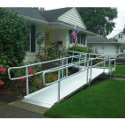 Modular metal ramps are also popular, as they only need to be fitted together at the home, greatly reducing the installation time and cost. However, a modular metal ramp typically costs a good deal more than it would cost to build a wooden wheelchair ramp. It is more durable though and many like the shiny metal look over the wooden feel offered by a wooden wheelchair ramp.
Modular metal ramps are also popular, as they only need to be fitted together at the home, greatly reducing the installation time and cost. However, a modular metal ramp typically costs a good deal more than it would cost to build a wooden wheelchair ramp. It is more durable though and many like the shiny metal look over the wooden feel offered by a wooden wheelchair ramp.
Threshold Ramps
When deciding what type of ramp to purchase, it is important to consider whether a full ramp is needed or simply a threshold ramp. For very short distances, a threshold ramp can be a very cost effective type of wheelchair ramp, which is basically a metal plank that attaches to the door frame and can usually bridge a few steps. However, a threshold ramp will only work on very short distances.
Drawbacks of Using a Wheelchair Ramp
While wheelchair ramps can be cost effective, they have two major drawbacks. One is the amount of space they take up in the yard. The length of the ramp is directly related to the height of the staircase, so in many cases, a wheelchair ramp will have to be very long, taking up a good deal of real estate on the lawn. Not only can this be a drawback when it comes to how the home looks, but for those with animals or small children, this loss of yard space can greatly affect how the home is used.
The other main drawback is that even though the incline is not very large, you still must move the wheelchair up what is essentially a hill when you use a wheelchair ramp. In the case of some older wheelchair users and those who use manual wheelchairs, this might not be possible. Even if you have someone to push the person up the ramp, it can require a great deal of effort and there are some risks associated with wheelchair ramps.
Vertical Platform Lifts
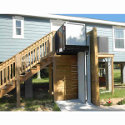 Another option for those who use mobility vehicles, like wheelchairs and electric scooters, is the vertical platform lift. Vertical platform lifts are also called wheelchair lifts and provide what is essentially a mini-elevator that is installed next to the front steps. A metal platform, of varying size, is provided for the wheelchair user to drive onto. When activated, the platform rises upwards until it is parallel with the front steps.
Another option for those who use mobility vehicles, like wheelchairs and electric scooters, is the vertical platform lift. Vertical platform lifts are also called wheelchair lifts and provide what is essentially a mini-elevator that is installed next to the front steps. A metal platform, of varying size, is provided for the wheelchair user to drive onto. When activated, the platform rises upwards until it is parallel with the front steps.
While in functionality a wheelchair lift is very similar to an elevator, the entire unit is self contained, so there is no need to build an elevator shaft or worry about running any cables. Instead, once the wheelchair lift is assembled, it can simply be placed where it is needed and turned on, instantly bridging the gap between the ground and the front steps.
These devices are also called porch lifts, because they are usually used on the front porch of a home, but they are also popular in schools and other commercial buildings.
Porch lifts include a number of safety settings, with doors available for both the top and bottom of the staircase. This can be important, because to install a porch lift it is usually necessary to remove a section of the handrail at the top of the landing. A door with call button at the top of the landing can serve as a gate, preventing falls when the porch lift is at the bottom of the staircase.
Vertical platform lifts are very popular because they are easy to install and do not take up much space. As a result, they can be used in many areas where a wheelchair ramp would not fit or would take up too much yard space. These wheelchair lifts are also quite powerful, with most supporting around 700 pounds and can span distances of up to 12 feet. In some cases where the porch is very high off the ground, the amount of space required to make a wheelchair ramp would be very excessive, where using a wheelchair lift requires only a few feet.
Due to their weight capacity, wheelchair lifts can also be used as service elevators, making moving heavy objects up the stairs much easier. It is also not uncommon for two people to use the porch lift at once, with one in a wheelchair or mobility scooter and the other behind them.
Wheelchair lifts do, however, cost more than most wheelchair ramps, although this is not always the case with modular metal wheelchair ramps, which can end up being pretty expensive as well.
A Look at Vehicle Wheelchair Lifts
Wednesday, August 19th, 2009
One of the most difficult aspects for many users of electric wheelchairs is figuring out how to safely and easily transport their mobility vehicle.
Often times, portable models are available, but most portable electric wheelchairs are lacking in features and functionality, in an effort to reduce weight. As a result, even though portable power chairs are often much easier to transport, they commonly lack the range, speed, and comfort that is offered by a full sized power chair. Fortunately, vehicle wheelchair lifts provide a easy and reliable way to transport most electric wheelchairs.
Hitch Mounted Wheelchair Lifts
The Hitch Mounted Wheelchair Lift is the easiest type of wheelchair lift to install or remove. All it requires is a square hitch installed on the vehicle. Most vehicle wheelchair lifts require at least a Class II hitch and to get the full weight capacity of the lift, a Class III hitch.
To install a hitch mounted wheelchair lift, it is simply slid into the square hitch and secured with a pin. For electrical models without their own battery pack, most can simply be plugged into the vehicles trailer light plug.
There are actually several different types of hitch mounted wheelchair lifts available, but most use an electrical lifting platform, which lowers to the ground and allows the wheelchair to be driven onto. The platform is then raised and the power chair secured. Some include an automatic lockdown arm, which holds the wheelchair in place as the wheelchair lift rises. Other require that the user strap down the power chair.
There are also tilting models available that use no power at all, which are popular for lighter electric wheelchairs.
The major advantage of a hitch mounted wheelchair lift is that it can be installed in only a few minutes without any modification to the vehicle. Subsequently, it can be removed just as easily.
Crane Wheelchair Lifts
Crane Wheelchair Lifts operate similar to a crane on a construction site. A harness is attached to the wheelchair, which is then hoisted off of the ground and moved into the vehicle by the crane lift. Often, crane lifts are installed into the trunk of a car or other area with minimal space. In these cases, the seat of the wheelchair will typically have to be removed before raising the wheelchair off of the ground.
There are also hitch mounted crane lifts available, which are especially popular on trucks, as they can quickly and easily move a wheelchair into the bed of a pickup truck and do not require any permanent installation.
When investing in a crane wheelchair lift, it is a good idea to go with one that has powered rotation. Powered rotation means that the cranes boom can be operated with a remote control, so swinging the wheelchair into the vehicle does not require any more effort than pushing a button.
Internal Wheelchair Lifts
Internal wheelchair lifts are very popular and use an electric platform to extend a platform from the vehicle. The wheelchair is driven onto the platform, which then lifts the wheelchair and stores it inside of the vehicle.
Internal wheelchair lifts are probably most recognized as van lifts, which are installed in the passenger compartment of a van, after a row of seats has been removed. However, they can also be installed into the trunk of an SUV or Van.
One of the major advantages of using an internal wheelchair lift is that the wheelchair is stored inside the vehicle, away from the elements. Of course, this comes at the cost of lost space. For those who drive themselves around, a van wheelchair lift can make transferring into and out of the drive seat much easier though.
Internal wheelchair lifts require a more permanent installation than other types of wheelchair lifts.
Vehicle Mobility Scooter Lifts
For mobility scooter users, vehicle scooter carriers are available that are similar to those described above. In fact, there are a number of universal vehicle wheelchair lifts that can be used with both electric wheelchairs and mobility scooters. However, there are also some that will only work with wheelchairs or scooters. For mobility scooter users, it is important to know how many wheels the mobility scooter has, either three or four, as this is one of the most important factors when determining if a wheelchair lift will work with a mobility scooter.
Vehicle Wheelchair Lifts
Saturday, August 15th, 2009
Wheelchairs and mobility scooters are very important mobility vehicles used by millions all over the World. Since many people do not only stay at home, it is typically necessary to find a means of transporting these types of mobility vehicles in your car or truck.
One option is to simply place the mobility vehicle in the trunk or back seat of the automobile. This is of course not possible with large electric wheelchairs and mobility scooters, but it is often a choice when dealing with manual wheelchairs, travel wheelchairs, and travel scooters. However, in the case of the latter two, many features have been removed to make these devices lightweight and easy to disassemble, so for everyday use, a travel scooter and portable wheelchair is often not preferable.
Wheelchair Lifts
Using a wheelchair lift, on the other hand, allows the mobility vehicle to be transported in a car, truck, SUV, or van without having to disassemble the wheelchair or scooter. There are different types of wheelchair lifts available for the three basic types of mobility vehicles; mobility scooters, electric wheelchairs, and manual wheelchairs, but they operate similarly.
 One of the most common types of vehicle wheelchair lifts available is the hitch mounted wheelchair lift. These are popular because they can be slid into a standard square hitch and installed with little or no actual modification to the vehicle. The Class of the hitch, either Class I, II, or III, is important though, as this is a factor that affects how much weight the wheelchair lift can support.
One of the most common types of vehicle wheelchair lifts available is the hitch mounted wheelchair lift. These are popular because they can be slid into a standard square hitch and installed with little or no actual modification to the vehicle. The Class of the hitch, either Class I, II, or III, is important though, as this is a factor that affects how much weight the wheelchair lift can support.
Usually a hitch mounted wheelchair lift will provide an electronically powered lifting platform that the wheelchair can be driven onto and then automatically raised. Often, as an accessory a swing away arm is available, that allows the wheelchair platform to be swung away so the trunk area of the automobile can be accessed. There are also un-powered models available, which are popular for manual wheelchairs, that use a tilting system.
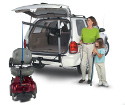 Another type of vehicle wheelchair lift, which is very popular in cars, is the crane wheelchair lift. Crane lifts can be installed in the trunk of a car and swivel away from the vehicle. A harness is attached to the wheelchair, which is subsequently raised and moved into the trunk.
Another type of vehicle wheelchair lift, which is very popular in cars, is the crane wheelchair lift. Crane lifts can be installed in the trunk of a car and swivel away from the vehicle. A harness is attached to the wheelchair, which is subsequently raised and moved into the trunk.
One thing to consider when using a crane lift is whether or not it has powered rotation. Powered rotation means that instead of having to push the cranes arm and wheelchair into and away from the trunk, you can simply push a button and it will swivel electronically.
Usually crane lifts require that the seat of the wheelchair be removed to save space if it is being used in the trunk of a passenger car. There are also hitch mounted crane lifts available, which are popular for use with trunks or extremely limited trunk space.
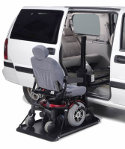 The other type of vehicle wheelchair lift is the internal platform lift. These are installed inside of a vehicle, often in place of a row of seats in a van or in the back of an SUV. The platform extends from the vehicle, allowing the wheelchair to be driven onto the platform, which then retracts storing the wheelchair inside of the vehicle. These wheelchair lifts are popular because the store the wheelchair safely inside the vehicle, however they require a more permanent installation and can take up a great deal of internal vehicle space.
The other type of vehicle wheelchair lift is the internal platform lift. These are installed inside of a vehicle, often in place of a row of seats in a van or in the back of an SUV. The platform extends from the vehicle, allowing the wheelchair to be driven onto the platform, which then retracts storing the wheelchair inside of the vehicle. These wheelchair lifts are popular because the store the wheelchair safely inside the vehicle, however they require a more permanent installation and can take up a great deal of internal vehicle space.
Incline Platform Lifts and Vertical Platform Lifts
Wednesday, July 29th, 2009
Wheelchair users, both at home and away, usually have trouble with areas that have stairs. Areas with stairs can be very difficult for those using wheelchairs to access. Around the home, this can greatly decrease accessibility, as most homes have a staircase on the front of the home and may also have one inside. To help increase accessibility at home, many people use vertical platform lifts and inclined platform lifts, both of these devices greatly increase accessibility by allowing a wheelchair user full access to their home.
What are Vertical Platform Lifts?
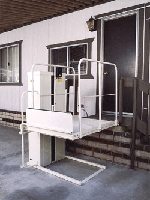 Vertical platform lifts, which are commonly called wheelchair lifts, are most often used on the front steps of a home. The entire unit is basically an elevator, with a strong lifting motor, elevator shaft, and lifting platform all rolled into one single unit.
Vertical platform lifts, which are commonly called wheelchair lifts, are most often used on the front steps of a home. The entire unit is basically an elevator, with a strong lifting motor, elevator shaft, and lifting platform all rolled into one single unit.
A wheelchair lift is placed next to the landing of a staircase. A large metal rectangle or square is provided, which the wheelchair user drives their wheelchair directly onto. The platform then raises vertically to the top of the landing and back down again. Depending on what type of vertical platform lift is used, there are many safety features available. For instance, many include locking doors on the platform, to reduce falls. It is also common for a door to be placed at the top of the landing.
Vertical platform lifts can usually support a minimum of 500 pounds, although this can vary by model, with some supporting more than 700 pounds. Due to their weight capacity, vertical platform lifts can be used by those with manual wheelchairs, electric wheelchairs, and mobility scooters. It is also often possible for multiple people to use the wheelchair lift at once, providing they do not exceed the weight capacity of the device.
While wheelchair lifts work very well on the front of the house, they do not always work on interior staircases. This is because the lift must be placed next to the landing and then raises the user up to the top of the landing. For many interior staircases, this setup just simply does not work.
Inclined Platform Lifts
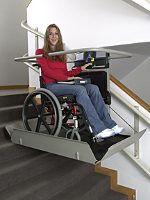 To provide interior access to a home with an interior staircase, it is often necessary to use an incline platform lift. Inclined platformed lifts provide a metal track that is attached to the wall of the staircase and runs its entire length. The wheelchair user is carried up the staircase on a platform, which is attached to the metal track.
To provide interior access to a home with an interior staircase, it is often necessary to use an incline platform lift. Inclined platformed lifts provide a metal track that is attached to the wall of the staircase and runs its entire length. The wheelchair user is carried up the staircase on a platform, which is attached to the metal track.
Inclined platform lifts can be used on most types of staircases, including curved ones. However, they do take up a good deal of space on the staircase. This is because the platform that carries the wheelchair user must be large enough for the person and their wheelchair, while also containing guard rails and an electric motor. So, an incline wheelchair lift may not fit on smaller staircases.
Inclined wheelchair lifts can usually be used by those in manual wheelchairs and electric wheelchairs, as well as people using mobility scooters. An incline platform lift operates very similarly to a stair lift, which is used by seniors who have difficulty using the stairs.
Both vertical platform lifts and inclined platform lifts are very popular in commercial settings, such as schools, churches, and office buildings.
Deciding Between Wheelchair Lift or a Wheelchair Ramp
Monday, July 27th, 2009
For someone who relies upon a wheelchair or other type of mobility vehicle, using the stairs can be very difficult, if not impossible. As a result, when away from home it is typically necessary to avoid areas with staircases. However, at home this is often not a practical response, as avoiding the staircase might mean you can not get into or out of your own home. To improve accessibility and make it easier to gain access to their home, many wheelchair users choose to install a wheelchair ramp or a vertical platform lift on their front steps.
Wheelchair Ramps
In some instances, choosing to install a wheelchair ramp will be the least expensive option to improve accessibility. Many people custom build a wheelchair ramp out of wood or hire a company to do so, which can be very affordable. It is also possible to buy a modular wheelchair ramp kit, which is made of metal and comes in sections. The height of the staircase dictates how many sections are required and when the ramp arrives, the individual sections are joined together.
When there is only one or two steps that must be overcome, a number of threshold wheelchair ramps are available, which are inexpensive and do not require much installation.
While in some cases a wheelchair ramp is less expensive, in the case of modular wheelchair ramps, there is often little difference in the cost of a vertical platform lift. Wheelchair ramps can also take up a lot of space in the yard, with the amount of space dependent on how high the staircase is. Using a wheelchair ramp is also sometimes difficult for those who use manual wheelchairs.
Wheelchair Lifts
Vertical platform lifts are basically a self contained elevator, which includes an elevator shaft, lifting motor, and lifting platform, all in one unit. Vertical platform lifts, which are often called wheelchair lifts, are installed next to a staircase’s landing and raise vertically between the ground and the landing of the staircase. The user simply maneuvers their wheelchair onto the wheelchair lifts platform and pushes a button, with the wheelchair lift doing the rest.
Most wheelchair lifts have a default lifting height that is around four feet. The device can then usually be upgraded to up to 12 feet, depending on the needs of the user. Most wheelchair lifts support around 500 pounds, with models available that can support over 700 pounds. As long as the lifts weight capacity is not exceeded, multiple people can use the wheelchair lift at once, which can be very useful for caregivers.
Vertical platform lifts require a solid base that is designed to support both the weight of the lift, which is quite heavy, and the weight of the people who will be using the device.
While wheelchair lifts are very easy to use and make using the stairs simple and trouble free, they do typically cost more than a wheelchair ramp, although this is not always the case with modular wheelchair ramps. Most wheelchair ramps cost between $3,500 and $12,000.
Deciding between a wheelchair lift or a wheelchair ramp is an important choice, which should take into account the location where the device is needed, as well as the physical attributes of the person who will be using it.
Vertical Platform Lifts vs Wheelchair Ramps
Tuesday, July 21st, 2009
For those that use wheelchairs, the stairs can present an obstacle that is very difficult to overcome. In some cases, it is possible to simply avoid traveling in areas that have stairs. However, around the home simply avoiding the stairs is typically neither practical or possible. There are several options to help make a homes staircase more accessible, but most people either install a vertical platform lift or a wheelchair ramp. Both of these options have their own advantages and disadvantages, which should be carefully weighed when making a home accessible.
Vertical Platform Lifts
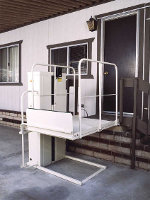 Vertical platform lifts are one of the most efficient ways of allowing a wheelchair user to travel over the stairs. Vertical platform lifts, which are often referred to as wheelchair lifts, are basically like a self contained elevator. The lifting platform, motor, and elevator shaft are all contained in a single unit, which can be placed next to a staircase to improve accessibility. The lifting height varies by model, but most have a default lifting height of around four feet, which can then be upgraded to about twelve feet.
Vertical platform lifts are one of the most efficient ways of allowing a wheelchair user to travel over the stairs. Vertical platform lifts, which are often referred to as wheelchair lifts, are basically like a self contained elevator. The lifting platform, motor, and elevator shaft are all contained in a single unit, which can be placed next to a staircase to improve accessibility. The lifting height varies by model, but most have a default lifting height of around four feet, which can then be upgraded to about twelve feet.
Vertical platform lifts are plugged into a normal electrical outlet and provide a platform for the user to drive their wheelchair onto. Then, the platform can be raised and lowered to allow full access to the home. Some wheelchair lifts include locking gates, both on the lifting platform itself, as well as at the top of the staircase landing to increase safety. Locks are also available, which may be required for commercial wheelchair lifts.
Usually the weight capacity of a vertical platform lift is at least 500 pounds, although some can support more than this. It is possible for more than one person to use the wheelchair lift at once, providing this does not exceed the weight capacity. They can also be used to move boxes or other items up and down the stairs.
Vertical platform lifts require a strong base that can support the weight of the lift, as well as the weight of the people using it. The base can be made from concrete or wood, providing it is sufficient to support the weight and stable.
The cost of a vertical platform lift varies, but usually they cost between $3,500 and $11,000. The installation of a vertical platform lift is straightforward and not very difficult, but the unit itself can be very heavy, so getting it in place may be difficult for some.
Wheelchair Ramps
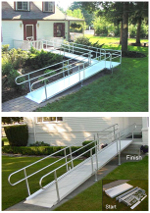 Installing a wheelchair ramp will often be a lower cost alternative to a wheelchair lift. Ramps can be custom made out of wood or metal ramp kits can be bought and assembled. The metal ramp kits typically come in sections, which are assembled at the home, and are referred to as modular wheelchair ramps. The height of the staircase will determine how many sections are needed. In some cases, modular wheelchair ramp kits can prove to be just as expensive as a wheelchair lift.
Installing a wheelchair ramp will often be a lower cost alternative to a wheelchair lift. Ramps can be custom made out of wood or metal ramp kits can be bought and assembled. The metal ramp kits typically come in sections, which are assembled at the home, and are referred to as modular wheelchair ramps. The height of the staircase will determine how many sections are needed. In some cases, modular wheelchair ramp kits can prove to be just as expensive as a wheelchair lift.
Wheelchair ramps offer the advantage of not requiring any electricity to function and since there are no moving parts, there is little about the ramp that can break. However, wheelchair ramps can take up a lot of space in a persons yard and the higher the staircase, the more space they will take up. Using a ramp can also prove to be very strenuous for those who use a manual wheelchair.
When choosing between a wheelchair ramp and a vertical platform lift, it is important to consider the location where the accessibility aid will be installed, as well as the condition of the person who will be using the device. However, for small staircases, which consist of only a step or two, there are a number of threshold ramps available that will be much more practical than a wheelchair lift would be.